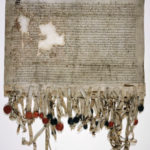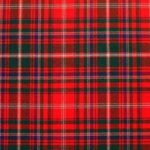You may have noticed I’ve been making a big deal of Tartan Day. Why? What is it?
National Tartan Day was designated by proclamation to be held on April 6th each year to recognize the contributions of Americans of Scottish descent. The holiday originated in Nova Scotia, Canada, where it was proposed in March 1986. The first proclamation was given the following year.
The Scottish Coalition USA met in Sarasota, Florida, in 1997, to start the process of recognition in the United States. This led to a resolution to adopt April 6th as Tartan Day. On 9 March 2005, House Resolution 41 to celebrate Tartan Day was passed.
Why April 6th? The Declaration of Arbroath was written on that date in 1320. It was a letter to the Pope from the Chancellor of Scotland and Abbot of Arbroath, Bernard of Kilwinning. The Declaration asserted Scotland’s status as an independent kingdom. It was written in Latin, and it was not until the 1680s that the document was printed. It was sometime after that when it was translated into English. The most widely quoted lines from the document are:

“… for as long as but a hundred of us remain alive, never will we on any conditions be brought under English rule. It is in truth not for glory, nor riches, nor honours that we are fighting, but for freedom – for that alone, which no honest man gives up but with life itself.”
Do you hear echoes of Patrick Henry’s lines? “I know not what course others may take; but as for me, give me liberty or give me death!” Henry was the son of a Scottish immigrant from Aberdeenshire.
If you compare the sentiment of the Declaration of Arbroath with the American Declaration of Independence, you find many

similarities. And it should come as no surprise as the American Declaration was modeled after the earlier one. A large proportion of our Founding Fathers were of Scottish descent, with almost half of the signers and nine of the thirteen governors of the newly established states of Scottish heritage. James Wilson and John Witherspoon, two signers, had themselves immigrated.
Why Tartan Day? Tartan is something uniquely Scottish. Plaid fabrics of crisscrossing horizontal and vertical lines have been around since the earliest times. Tartan refers to a unique pattern associated with a specific clan, organization, or geographic location. These began to be seen in the late 16th century. However, it wasn’t until the 1800s that these were identified. Registration began in 1815 when the Highland Society of London (formed in 1778) required all chieftains to submit samples of their tartans to be registered. These samples had to be large enough to show the entire pattern.
The oldest proven tartans were associated with local areas. And there are several theories for this including that weavers in those areas preferred specific patterns or that they had access to certain plants and other items for dyes. The inhabitants would dress in the locally available fabrics. The oldest plaid pattern is the Falkirk sett, dating to the 3rd century BC, which was created using light and dark sheep’s wool and was not connected to any particular clan. It is often called shepherd plaid and was found in trousers, not the kilt. It was not uncommon for people to wear several patterns simultaneously. I saw some early iron-age evidence of this at the local Kelten-Romer museum here in Bohemia. Unfortunately, the reflection of the glass ruined my photo. Oh well, it gives me an excuse to go back.
My own family is part of that diaspora descending from MacDougals on my father’s side and MacIntyres on my mother’s. My husband has Fergusons and Mackenzie immigrants. So we celebrate the day. While we may enjoy a bit of whiskey and listen to some good music, I pass on the haggis and blood pudding.

As I dedicated March to Irish month, I will focus on Scotland this month.

Happy Tartan Day!
